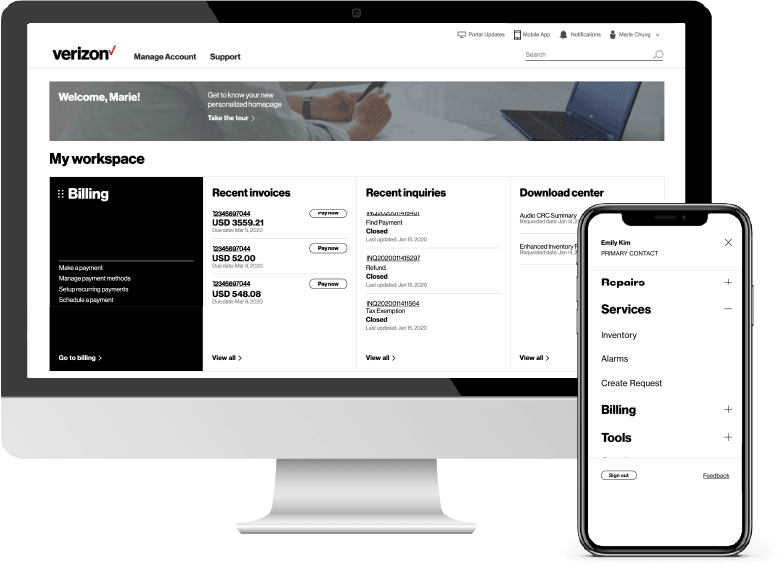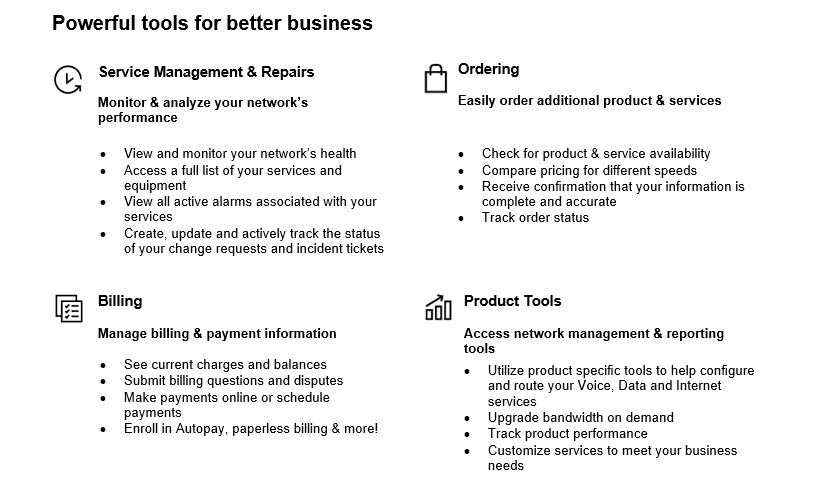-
Overview
-
IP Contact Center is Verizon’s comprehensive inbound solution that helps you enhance your customers’ experience.
IPCC is a portfolio of interaction services that includes VoIP Inbound and IP Interactive Voice Response (IVR). Our network-based portfolio includes VoIP conversion for reliable termination to Session Initiation Protocol (SIP) devices. With IPCC, you gain the benefits of automatic technology upgrades, a fully managed hosted service and secure connectivity on one of the world’s largest IP backbones.
Our comprehensive IP Contact Center service gives you all the usage-based features you need, and the tools to make near-real time changes quickly and efficiently. VoIP Inbound options include local to global calling with domestic toll-free and local services as well as international inbound that can be layered with dozens of advanced features to fit the needs of your business.
With IPCC your inbound traffic can be directed by:
- Routing or blocking callers using Automatic Number Identification (ANI).
- Delivery of caller-entered digits from IVR prompts
- Caller Profile routing based on your systems knowledge of Customer Relationship Management (CRM)
- Call routing using time of day and/or Geographic area
Additionally, the routing tool, Network Manager, allows you to easily view your entire network configuration, make changes, or order/activate new features. You can also extract traffic management reporting utilizing Traffic Reporting and Traffic Monitor so you can have your finger on the pulse of your callers. This puts you in control by helping you make quick changes to your calling plans and follow your business in near-real time.
- Overview
- Your Verizon team
- Preparing your site
- Steps for a successful delivery
- Business continuity plan
- Installations
- Manage your account with Verizon Enterprise Center
- Reporting and tools
- Service Features
- Network Operations Center (NOC)
- Training and service contact information
- Frequently asked questions
- Important Links
-
IPCC Helpdesk works with the IPCC Project Coordinator who oversees and drives completion of each IPCC project and change request. The IPCC Helpdesk is responsible for providing data gathering and verification of all the information required for an IPCC order request. Your assigned IPCC Project Coordinator will work with you throughout the project and will maintain a project tracker which includes project milestones and status updates.
The order request is submitted to the Order Management team for processing once all pertinent information has been obtained.
-
- Acknowledge and review IPCC Help Desk Ticket
- Participate in internal and external calls with the Project Coordinator as necessary
- Perform data gathering
- Assist customers in establishing Inbound Network Manager access and training
- Create the order for submission
- Assist with obtaining Customer Service Records (CSR), prequalification and other forms
- Provide and coordinate the Letter of Authorization for porting to Verizon from other carriers
- Track order progress to completion.
- Acknowledge and review IPCC Help Desk Ticket
-
- The Verizon Account Team or you can send a request to [email protected]
- The ticket that will be generated will serve as your main ticket for the order.
- A Project Coordinator will be assigned to acknowledge and monitor end to end order completion.
- The Verizon Account Team or you can send a request to [email protected]
-
The Order Manager (OM) is the primary contact for you regarding your IP Contact Center Services. Your Order Manager will communicate as needed in the form of periodic emails and/or follow-up calls to provide status on key information regarding the implementation and activation of your IP Contact Center Service.
The Order Manager will work all aspects of the order directly with you and will gather any additional information needed.
Below is a list of activities to be performed by the OM:
- Send an order verification e-mail.
- Act as the ultimate point of escalation.
- Confirm on-time delivery of the project and will pursue/escalate any unmet milestone deadlines.
- Act as the point of contact for any order-related issues.
-
Your Solutions Architect (Design Engineer) is responsible for the physical and logical design and development of your IPCC connectivity.
Below is a list of activities to be performed by the Solutions Architect:
- Meet with you to collect requirements and technical details.
- Create your organization’s custom IPCC Design Document.
- Work with you to help develop an application Test Procedural Document (if applicable).
- Review & verify your hardware and software configurations.
- Review redundancy, availability requirements, and security requirements.
- Determine bandwidth and sizing requirements.
- Review IP addressing scheme
- Make revisions to the IPCC Design Document, as required.
- Assist in the creation of IPCC orders and perform field trials, if required.
-
The role of the Implementation Engineer is to provision the order, provide Session Initiation Protocol (SIP) peering information to the customer to configure their CPE, answer any customer technical and connectivity questions, and sign-off on a successful Activation Call.
Below is a list of activities to be performed by the Implementation Engineer:
- Provision the Verizon network
- Provide SIP peering information for customers to configure their CPE
- Work with customers on scheduling a mutually available, formal Activation Call date/time.
- Validate Verizon SIP OPTIONS messages are being sent to customer
- Validate the correct IP Address subnets are advertised on the customer MPLS VPN
- Place test calls and capture logs during the formal Activation call, validating the correct SIP messaging
- Answer any Verizon network provisioning questions
- Engage other team members for provisioning questions as required
- Formally activate service
-

-
For more detailed information about preparing your site for your upcoming installation (either performed by you or Verizon), please refer to Verizon’s Customer Readiness website.
Your order manager will review the site and other requirements with you on the Customer Kickoff Call/Order Verification Call.
Customer action
To ensure that the IPCC Services project stays on schedule, customer needs to review the design information with Solutions Architect.
-
Design Document
- The Design Document is a vital portion of IPCC Services offering. The customized document provides you with the technical details related to your solution and works as the source document Verizon leverages for all of your VOIP Services.
- The Solutions Architect (SA) is responsible for developing the high level design.
- A typical Engineering Design Document would include these sections
- Network details
- Access type
- VPN information
- IP addressing
- VoIP/IP telephony*
Customer action
Service activation requires customer to check connectivity prior to the scheduled date for activation. Please review the following site readiness details below, and take appropriate action as needed.
Turning up IPCC services, the customer must ensure the following items are checked before the schedule activation date.
- Customer has received all Session Initiation Protocol (SIP) peering information from Verizon
- Validate the Verizon SIP configuration pre-activation material
- Domain Name System (DNS), Fully Qualified Domain Name (FQDN), Customer IP, Customer Media IP, Verizon Session Border Controller(SBC) subnets
- Customer network is receiving the Verizon SBC’s IP Address subnet advertisements
- IPCC enterprise’s come with SBC diversity (n+1)
- Each Verizon SBC IP Address subnet will be a /24 broken down to two /25 subnets
- Sample-Verizon SBC1 - 172.31.20.0/25 and 172.31.20.128/25
- Sample-Verizon SBC2 – 172.31.25.0/25 and 172.31.25.128/25
Note : The Verizon SBCs are “pooled”, meaning that each Verizon SBC will have a logical SIP trunk to “each” of the customer termination IP Addresses (i.e. many-to-many connectivity)
Customer can check core network connectivity with an ICMP PING to one of the Verizon SBC management IP Addresses
- Sample 172.3x.x.1, 172.3x.x.2, 172.3x.x.3
- Successful PING test with just one of the above is sufficient
Customer SIP termination IP Address (Host IP address only, no ranges) are configured and advertised, including the correct UDP port of 5060
- Sample Customer CPE is 10.1.1.5 listening on UDP port 5060
SIP option keep-alives are sent by Verizon SBCs and require a customer response for keeping the SIP trunk in-service
- Any valid customer SIP response is accepted
- Sample 2xx, 4xx
- If the customer provided equipment does not reply back to the OPTIONS ping, the service will not work
- Verizon will also reply to customer generated OPTIONS ping but this does not guarantee that services will work
Any questions and concerns can be addressed prior to the scheduled formal Activation Call. The Activation Call should be used to place successful test calls, verify two-way audio and voice quality, as well as capture call logs. Joint troubleshooting of issues encountered are worked on these calls. The customer is responsible for all configuration of customer managed equipment including network and CPE devices. Customer should plan ahead to have all applicable network and CPE personnel necessary to support the Activation Call should troubleshooting be required.
-
Steps for a Successful Delivery of your IP Contact Center Services
To successfully deliver your IP Contact Center Service, there are some activities that must be completed by both Verizon and you. Our goal is to keep you informed and aware of all the steps.
Customer Steps
The following steps on your part will also lead to a successful and timely delivery of your IP Contact Center Services:
- Get set up with a VEC User ID.
Note: For more information about the VEC, you need to refer to the section “Manage your Account with Verizon Enterprise Center (VEC)” in this Welcome Kit.
Enroll in Network Manager training. This can be done by accessing this site: https://customertraining.verizon.com/
Note: Separate login and website registration may be required.
Confer with a Solutions Engineer about:
- Overall architecture, connectivity, and design of the IPCC solution
- Documenting all the applicable touch points and their technical details into an IPCC Design Document
- Transition of any legacy and/or TDM services and how they relate to/differ from the new IPCC platform
- Best practices in regards to platform architecture, optimization of Routing and DNIS modeling, and co-existing with tangent services
- Performing interoperability testing (a.k.a. Field Trial) to ensure the project success
Review the numbers you want to port to Verizon and notify Verizon
Notify Verizon as far in advance as possible of any times during which activations or installations may not be scheduled so as to not impact your delivery schedule
If a change to the established activation/installation date is required, communicate those changes as soon as possible to your Order Manager.
Inform Verizon of any networking changes (your facility, 3rd party changes, etc.) that are relevant to your IP Contact Center Services.
Verizon Steps
Verizon will take the following actions to provide a smooth implementation of your IP Contact Center Services:
- Verizon Account Team will work with you to complete a Supplemental Form. The Form will be used by your Verizon Service Delivery Engineer/Solutions Architects to properly configure the IPCC Services.
- An IPCC Help Desk representative and Project Manager will facilitate data gathering and tracking of the project milestones.
- During the order process, the Order Manager will verify the following information:
- Number of IP Terminations and/or IP Originations
- Billing information
- Porting TNs (if applicable)
- The letter of Authorization needs to be provided for this step.
- IPCC Domain Name – The Service Name the customer wishes to use. Include “IPCC” in the name.
- Circuit information, including circuit ID, VPN name, CPE SIP IP, and primary customer contact. Confirm if there is an existing Network Capacity Assignment Request (NCAR), as well as whether the router is managed by Verizon.
Your IPCC Project Manager will work with you to coordinate the schedule of the activation of the services handled by Verizon IPCC Services. These are the dates Verizon will be ready to activate/install your service(s).
Customer action
It is required that you have a local contact onsite in each installation location on the due dates provided to avoid rescheduling and potential service downtime.
-
Service disruptions can hurt a company's bottom line and compromise an organization's mission. The economic and reputational imperatives of the current market have shifted the discussion from IT disaster recovery to an enterprise-wide business continuity focus.
Organizations of all sizes and industry types should have ongoing, enterprise-wide Business Continuity Programs that develop, prepare and exercise the various areas of continuity from critical business processes to IT service availabilities. The Business Continuity Program should address areas such as Emergency Response, Impact Analysis, Business Continuity Plans, Disaster Recovery Plans, Supplier Plans, Exercises, and ongoing BC program management.
The goals of today’s most relevant Business Continuity Programs are those providing organizations with an enterprise-wide business continuity focus, that not only includes strategizing and planning for IT service availability and disaster recovery, but addresses the ability to manage all areas of critical and continuity activities of the program. This comprehensive approach helps prepare and mitigate the impact of ever-increasing risks that threaten to interrupt organizations’ critical processes.
Key criteria your organization should consider when creating a relevant, enterprise-wide Business Continuity Program to help protect your business critical information and processes- The Executive Team has established enterprise-wide business continuity objectives
- The Business Continuity (BC) Program is
- Enterprise-wide, and extends beyond the IT department
- Part of the organization’s annual operational budget
- An on-going, steady-state operation of the business
- Regular assessments and reviews to validate business recovery requirements, priorities capabilities and compliance requirements
- IT Service strategies and recovery solutions to maintain effective service resiliency and availability aligned to the business requirements
- Appropriate emergency response, business continuity, communications and disaster recovery plans are designed and developed to provide proper guidance during an event
- Regular BC Program maintenance is being performed to manage the program changes
- Determine if you can/will manage the BC Program internally, or using a BC partner
- If a BC partner, determine those with the best capabilities to manage your organization’s size and needs
- Confirm the group or persons managing your BC Program is qualified, they have references, ISO accreditations and BC certifications
- Annual exercises and tests are performed before an event happens, validating your plans effectiveness
- Develop clear and simple methods, policies and procedures to follow
- Keep all resources properly trained
- Once the event is over, you should have a plan in place to bring your business back to normal operations
Verizon can help you with your Business Continuity planning needs
Verizon's portfolio of Business Continuity Consulting, Planning and Management help reduce the risk and impact from a disruption by providing enterprise-wide Business Continuity Programs that generate strategic solutions, formulate plans and manage program preparations to provide effective continuity measures should an unavoidable crisis occur.
With the Verizon Business Continuity Management portfolio of consulting services and programs, we help our customers to effectively prepare and maintain continuity during planned and unplanned events to help reduce the risk and impact from disruptions. Please contact your Verizon account team for further assistance
-

-
Verizon-performed Installations
There are several milestones in the service installation process customers should be aware of.
- After the initial service orders are placed, an Order Manager will be assigned to the order. Customers should direct all communications about the order through the assigned Order Manager.
- An Order Verification email will be sent shortly after the orders are placed. This email requires both Verizon, as well as the customer, to verify the technical configuration and customer environment details of the order.
-
Note: The Order Manager will hold the order until responses are received.
- The Implementation Engineer builds the Verizon side of the order. A Provisioning Integration Test (PIT) is conducted by the Implementation Engineer to validate the Verizon configuration and retrieve all the necessary configuration details to provide to the customer (e.g. Session Initiation Protocol (SIP) Signaling IP Addresses, User Datagram Protocol (UDP) Ports, Domain Names, test toll free numbers, etc.) This information is then sent to the Order Manager.
- The Order Manager provides all the configuration details in an email to the customer identifying that the service is ready for activation, and requests the customer identify a date/time that a formal Activation Call can be scheduled. The Order Manager requires a 72 hour advance window to coordinate resources for an Activation Call. After hours and weekend Activation Calls are by special request only, and subject to Verizon resource availability.
- At this point, the Verizon service is complete from a Verizon perspective. If a customer has their side already completed, a customer may go ahead and make some non-production test calls prior to the formal Activation Call.
- During a formal Activation Call, customers can expect to work with the Implementation Engineer to place test calls, validate two-way audio and voice quality, monitor for SIP messaging errors, and assist in troubleshooting. Additional Activation Call scheduling may be required if extended troubleshooting is required.
- Upon mutual agreement the activation was successful, the Implementation Engineer will complete the manual test and turn up the task in Provisioning Controller, and designate the order complete. The Order Manager will close the order out, noting that the formal Activation Call was successful.
- Formal activation is required.
-
Easily Manage your Services Online
The Verizon Enterprise Center makes it easy for you to monitor, manage, analyze and optimize your Verizon products and services online. Available seamlessly between desktop, tablet and smartphone – you can act on your crucial data wherever your work takes you.
-

-
Register for the Verizon Enterprise Center
- Go to sso.verizonenterprise.com/ or download the My Verizon for Enterprise mobile app
- Click the ‘Register’ link
- Enter the invitation code you received to complete registration.
-

-
Call Detail (CDR) is an important tool for any size enterprise to use to track inbound and outbound IPCC applications calling details for proper business management. It can help you pinpoint deficits and proficiencies within your center workforce. In addition, it offers opportunities to:
- Provide information on call length; (important for coaching opportunities), as well as call origination information; (used for future marketing purposes)
- Track success or failure of specific calling campaigns; (based on volumes and use of features for routing to specific answering locations)
- Improve interaction between you and your customers; (providing an improved customer experience and potential for increased revenues)
-
- With 38+ specific data headers highlighting information ranging from date and time to more specific caller information such as caller number, country/province/city and actual call duration, you have access to information that helps you trend your calls for specific operational conditions, measure the efficiencies of your outbound sales teams, or advertising response on an inbound calling campaign.
- Call Detail Records can be extracted once you are a subscriber to the Verizon Enterprise Center. In addition there are many self-help online courses to help you become familiar with your contact centers activities.
- For more information on available courses, reference: https://customertraining.verizon.com/
Note: For all Customer Training questions, please refer to the Training and Service Contact Information section below.
- With 38+ specific data headers highlighting information ranging from date and time to more specific caller information such as caller number, country/province/city and actual call duration, you have access to information that helps you trend your calls for specific operational conditions, measure the efficiencies of your outbound sales teams, or advertising response on an inbound calling campaign.
-
Service Features
-
Feature Descriptions
The table below provides IP based Interactive Voice Response (IVR) Functionality, offering the most-frequently used IVR features.
For additional information, please contact your account manager.
-

-
For issues found after your IPCC Activation and/or Porting calls have completed, please contact the appropriate Verizon Customer Support group discussed in the Customer Support section (in the left navigation area). Before initiating such contact, please confirm the root cause of the issue is not within your local area network or equipment you own and/or maintain.
Data Gathering Necessary for Opening a Ticket
Open a ticket as soon as an issue is confirmed in order to see fastest turnaround times. It is important to compile the necessary data when opening a trouble ticket.
1. Determine impacted service (for example, voice, data, etc.)
-
2. Information needed to progress a ticket:
- If IPCC Inbound: toll free or local number(s) impacted, description of issue and call examples (originating number, terminating number, date, time, time zone)
- If IPCC Outbound: Fully Qualified Domain Name (FQDN), Customer IP, description of issue and call examples (originating number, terminating number, date, time, time zone)
- If Data Circuit Issue: circuit ID, description of issue, local contact and site access hours in case dispatch is needed
- When opening a ticket on voice services, the more information provided will help make ticket resolution quicker and more straightforward.
Once a ticket is opened, additional information can be provided including specific call example (number called, number called from, time of call) when issue was experienced, traces, testing history, steps to reproduce the issue, and troubleshooting to date. To provide this information, send an e-mail to [email protected] with the ticket number only in the subject line or access the ticket via VEC via the following link https://verizonenterprise.com/
Customer Trouble Management
(for both Inbound and Outbound IPCC service conditions)
Option 1: Customer inputs an automated ticket via the online portal (VEC):
Customers can access the Verizon Enterprise Center (VEC) via this link:
https:// verizonenterprise.com/
In order to use this option for opening and checking status of tickets, customers must be registered….
Once in the VEC, follow these steps to submit necessary information for opening a ticket. The process is the same for inbound and outbound services:
- At the landing page, enter your User ID.
- Choose “Manage Account” among the options at the top of the page.
- Choose “Create a Repair Ticket”
- Enter the IPCC Service ID in the “Service ID” box (you do not need to choose a state for the IPCC product scenario).
- Fill out the required fields as indicated by the red asterisk (*), and provide details in the text box about your issue. You also have the opportunity to add attachments.
- Click “submit”.
To check status of your ticket:
- Once logged into the VEC, choose “Manage Accounts”
- Choose “View Repair Ticket”
- A list of repair tickets that have been entered will appear. Choose the ticket number that you are seeking status for.
- Your status will appear.
Option 2 : for US Enterprise customers only
Customer or Sales calls U.S. Help Desk for general inquiries, billing support or technical trouble management.
- If the customer has a special support number/group they should follow standard process to open a ticket.
- The agent might need to also select “any product” to ensure the ticket is associated under IPCC for the current platform.
- Customer/sales will need to include the pertinent information based on their trouble condition gathered in the previous Data Gathering section.
- When a ticket is opened, it will get routed based on the type of information provided.
- The agent will provide you with a ticket number; please make note of this number.
Escalation Guidelines
Verizon’s objective is to restore your services to their normal operating conditions quickly and efficiently. To accomplish this objective, NOCs and the Service Desk use escalation guidelines set up to push or drive issues to resolution.
Instead of escalating on the basis of time, escalations are value-based. The objective is to add value to the escalation process across the board for all customers and all circumstances, as well as to add standardization to the processes.
Note: You can request escalations at any time during an outage through your ticket in the VEC portal or by calling into the Service Desk.
Value-based escalation may be understood as follows:
- Service Desk will assess whether escalations are needed. If there is no progress since the previous review, an escalation is made to the next level of management.
- However, if the appropriate focus and resources are being applied, escalations may be deferred. Technical escalations by the NOC to local-exchange or third-party carriers follow the same value-add process.
-

-
Training
The Customer Learning Portal provides Verizon Business customers with training and resources for products, systems, and tools. To access the Customer Learning Portal, please go to https://customertraining.verizon.com.
Service Contact Information
The matrix below will provide you with the contact information you would need to handle any issues that may arise with your IPCC service:
Service issue
Repair - Virtual network services
Repair- Virtual network services-WAN analysis
Global change management
Be prepared with the following information:
MNS (Managed Network Service) or VNS identifier
(e.g. Cxxxxx or custdns-location-sof#-e00x)
Verizon enterprise center portal
Verizon Enterprise Center Link
Service team
Contact Assigned Service Team or subscribe to Premium Client Services (PCS)
Call
800-444-1111 (24 x 7).
Verizon enterprise center live chat
Verizon enterprise center link – Chat (available under “Support” > “Contact us & Send feedback”)
Account team
Contact assigned account team
Service issue
Maintenance notification
Be prepared with the following information:
MNS (Managed Network Service) or VNS identifier
(e.g. Cxxxxx or custdns-location-sof#-e00x)
Verizon enterprise center portal
Verizon Enterprise Center Link
Service team
Contact Assigned Service Team or subscribe to Premium Client Services (PCS)
Call
800-444-1111 (24 x 7).
Verizon enterprise center live chat
Verizon enterprise center link – Chat (available under “Support” > “Contact us & Send feedback”)
Account team
Contact assigned account team
Service issue
Verizon enterprise center tools and training
Verizon enterprise center portal
Verizon Enterprise Center Link
Service team
Contact Assigned Service Team or subscribe to Premium Client Services (PCS)
Call
800-444-1111 (24 x 7).
Account team
Contact assigned account team
Service issue
Billing
Be prepared with the following information:
MNS (Managed Network Service) or VNS identifier
(e.g. Cxxxxx or custdns-location-sof#-e00x)
Verizon enterprise center portal
Verizon Enterprise Center Link
Service team
Contact Assigned Service Team or subscribe to Premium Client Services (PCS)
Call
800-444-1111 (24 x 7).
Verizon enterprise center live chat
Verizon enterprise center link – Chat (available under “Support” > “Contact us & Send feedback”)
Account team
Contact assigned account team
Service issue
Order
Be prepared with the following information:
MNS (Managed Network Service) or VNS identifier
(e.g. Cxxxxx or custdns-location-sof#-e00x)
Verizon enterprise center portal
Verizon Enterprise Center Link
Service team
Contact Assigned Service Team or subscribe to Premium Client Services (PCS)
Call
800-444-1111 (24 x 7).
Verizon enterprise center live chat
Verizon enterprise center link – Chat (available under “Support” > “Contact us & Send feedback”)
Account team
Contact assigned account team
Contact your Sales representative who will work with the ordering and provisioning teams to initiate the order.
Contact your Sales representative to initiate discussion with internal resources about the contract.
Use the Network Manager tool in the Verizon Enterprise Center (VEC) to re-route toll-free numbers.
Please refer to the Training section of this document or contact the Verizon Enterprise Center (VEC) Help Desk and ask the Network Manager Help Desk.
Refer the Service Contact section under Billing. Alternatively, you may create an ICI (Invoice Inquiry) ticket through the Verizon Enterprise Center at https://enterpriseportal.verizon.com.
Traffic reporting in the Verizon Enterprise Center will provide you with inbound reports. You can refer to the Traffic Reporting section in this document for more information.
Contact your Sales representative for information about product offerings. You can refer to the list of products provided by clicking this link: https://enterprise.verizon.com/products/
Refer to the Network Operation Center section of this document for options relating to incident resolution.
You can often keep all of your numbers. However, some conditions could prevent some of your numbers from porting, such as regulatory limitations for some international countries. Your Order Manager or Sales representative will be able to tell you whether all of your numbers may be ported.
As most IPCC customers, you can attend one training to learn the basics about how to route your numbers to IP.
Network Manager IPCC VoIP Inbound – 1.5 hours
Offered twice a month – recorded replay available.
All public classes are free of charge.
If customers want to know more about available routing features, they may attend Network Manager classes. These classes are for customers who may want to see all advanced routing options, who continue to have some numbers on TDM/Switched, or just want to understand more about what features are available in Network Manager.
Note: Attend the Network Manager classes at https://customertraining.verizon.com. These courses build upon each other and should be taken sequentially.
The Traffic Reporting tool provides IPCC customers the ability to report on inbound call statistics including call detail and summary reports at the number level or domain level. Reports can be set up recurring or one time for specific dates and times. An instructor led class is offered once a month. A recorded class is available for replay. Customers are entitled for the Traffic Reporting tool in the Verizon Enterprise Center by their account team.
Services and/or features are not available in all countries/locations, and may be procured from in-country providers in select countries. We continue to expand our service availability around the world. Please consult your Verizon representative for service availability. Contact us.

